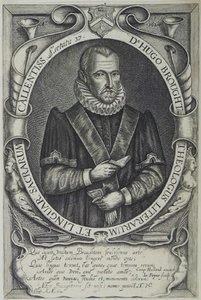| Method | Copper engraving |
| Artist | John Payne |
| Published | 1620 |
| Dimensions | Image and sheet 178 x 116 mm |
| Notes |
A half-length portrait of Hugh Broughton, wearing a ruff and gown, and holding gloves and a book. Third state; also appears as the frontispiece to Broughton's Works (1660). Title inscribed around oval, Latin inscription beneath image. Hugh Broughton (1549-1612) was an English scholar and theologian. Born in Shropshire, he was educated at Cambridge, and later became a fellow at St. John's and Christ's College. In 1588 he published his first work, A Concent of Scripture. Discussing biblical chronology and textual criticism, the work was attacked by both Oxford and Cambridge University. Broughton was forced to defend it in a series of lectures. Other works included An Epistle to the learned Nobilitie of England, touching translating the Bible from the Original (1597), Explication (1599), and A Revelation of the Holy Apocalyps (1610). A selection of his works was published in a large folio volume in 1662, with a sketch of his life by John Lightfoot. John Payne was a British engraver active between 1620 and 1642. Vertue wrote that Payne was 'the first Native that distinguishd himself by his Excellent burin being a forward Ingenious Young Man both in Graving & designing'. It is thought that he was trained by Simon de Passe. John Sturt claimed that although King Charles I had requested to meet him, Payne was too 'careless of his affairs' to attend. He is best-known for the print Sovereign of the Seas, and his book of plants Flora. William Faithorne was one of his pupils. O'Donoghue 1, Globe 23b.III, Hind III.9.5 (state undescribed). Condition: Trimmed to image and tipped to album page. |
| Framing | unmounted |
| Price | £45.00 |
| Stock ID | 37767 |

